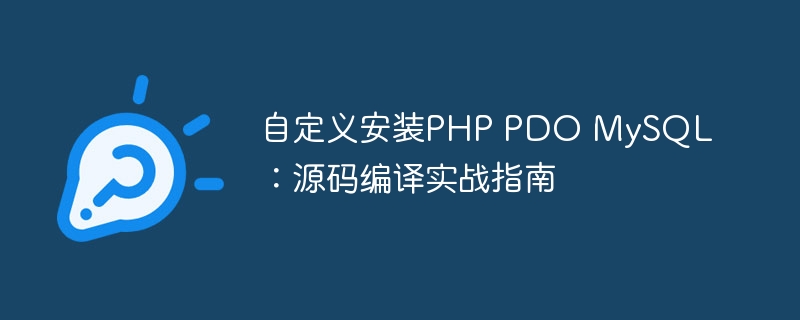Home >Backend Development >PHP Tutorial >Custom installation of PHP PDO MySQL: Practical guide to source code compilation
Custom installation of PHP PDO MySQL: Practical guide to source code compilation
- WBOYWBOYWBOYWBOYWBOYWBOYWBOYWBOYWBOYWBOYWBOYWBOYWBOriginal
- 2024-03-07 14:21:31760browse

Installing PHP PDO MySQL on different operating systems may not be a simple matter, because various systems may have their own unique installation methods and configuration requirements. In some special cases, we may need to customize the installation of PHP PDO MySQL to better meet our needs. This article will provide you with a practical guide to source code compilation to help you successfully complete the process, and will also provide some specific code examples for reference.
Confirm the environment and dependencies
Before compiling the source code, you first need to confirm the system environment and dependencies to ensure that the installation process can proceed smoothly. First, make sure that PHP, MySQL and related dependency packages, such as libmysqlclient, etc., have been installed in the system. You can check it with the following command:
php -v mysql -V
If the relevant dependency package has not been installed in the system, you can install it in advance through the package manager. For example, on the Ubuntu system, you can use the following command to install the MySQL dependency package:
sudo apt-get install libmysqlclient-dev
Download PHP source code package
After confirming the environment and dependencies, we need to download the PHP source code package. You can go to the PHP official website (https://www.php.net/downloads) to download the latest version of the PHP source code package, or use the following wget command to download:
wget https://www.php.net/distributions/php-7.x.x.tar.gz
Compile PHP
Download completed After the source code is packaged, we can start compiling PHP. First decompress the source code package and enter the decompressed directory:
tar -zxvf php-7.x.x.tar.gz cd php-7.x.x
Next, configure and compile PHP. During the configuration process, we need to specify to enable PDO and MySQL extensions, and also specify the installation path and version of MySQL. The following is an example configuration command:
./configure --with-pdo-mysql --with-mysqli=/path/to/mysql_config
After completing the configuration, you can start compiling and installing PHP. The compilation process may take some time and you need to wait patiently:
make sudo make install
After the compilation and installation are completed, you can verify the installation of PHP through the following command:
php -v
Configure PHP
After installing PHP, we need to configure PHP to enable PDO and MySQL extensions. You can edit the php.ini file to enable related extensions:
sudo vi /etc/php/php.ini
Find the following two lines and uncomment them:
extension=pdo_mysql.so extension=mysqli.so
Save and exit the file. Then restart the PHP service for the changes to take effect:
sudo service php-fpm restart
Test PDO MySQL connection
Finally, we can write a simple PHP script to test whether the PDO MySQL connection is normal. The following is a simple sample code:
<?php
$db = new PDO('mysql:host=localhost;dbname=mydatabase', 'username', 'password');
$stmt = $db->query('SELECT * FROM mytable');
while ($row = $stmt->fetch()) {
print_r($row);
}
?>Save the above code as test.php and access the file in the browser. If the data in the database can be output normally, the PDO MySQL connection has been successfully established.
Through the above steps, we successfully completed the source code compilation and installation of PHP PDO MySQL, and also performed basic configuration and testing. I hope this practical guide will be helpful to you and make it easier for you to complete the process of customizing the installation of PHP PDO MySQL.
The above is the detailed content of Custom installation of PHP PDO MySQL: Practical guide to source code compilation. For more information, please follow other related articles on the PHP Chinese website!

